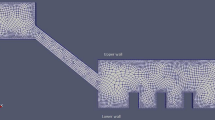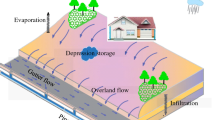Abstract
In this paper, the movement of the water surface with macroscopic particles during a dam break flow using the volume of fluid (VOF) methods and the DPM and MPM models were numerically simulated. The numerical simulation is based on the averaged Navier-Stokes equations, and was closed by the LES turbulent model, representing by the incompressible viscous fluid flow, equations for the phase and particle motion. The PISO numerical algorithm was chosen to solve this equation system numerically. The accuracy of the mathematical model and the selected numerical scheme were compared with experimental measurements on the destruction of the dam break problem. In test problem, the values were matched with measurement values and simulation data of other authors, as well as the improved model illustrated values close to the measured values. A matching was also made of the computational data with measured values using different turbulent models. One problem has been considered, the problem is water movement with macroscopic particles, through a heterogeneous terrain and a dam that has a hole. With the help of the problems, it was determined the flooding zones and the time of flooding evacuating people from dangerous areas.






Similar content being viewed by others
References
Agrawal M, Bakker A (2004) Macroscopic particle model – tracking big particles in CFD, AIChE 2004 annual meeting particle technology forum - paper 268b November 7–12. Texas, USA, Austin
Amicarelli A, Kocak B, Sibilla S, Grabe J (2017) A 3D smoothed particle hydrodynamics model for erosional dam-break floods. Int J Comput Fluid Dynamics 31(10):413–434
Azimian M, Lichti M, Bart H-J (2014) Investigation of particulate flow in a channel by application of CFD, DEM and LDA/PDA. The Open Chem Eng J 8:1–11
Bhaganagar K, Pillalamarri NR (2017) Lock-exchange release density currents over three-dimensional regular roughness elements. J Fluid Mech 832:793–824
Cao Z, Xia C, Pender G, Liu Q (2017) Shallow water hydro-sediment-Morphodynamic equations for fluvial processes. J Hydraul Eng 143(5):02517001
Chara Z, Kysela B (2018) Application of macroscopic particle model to simulate motion of large particles. AIP Conf Proceedings 1978:030031
Colagrossi A, Landrini M (2003) Numerical simulation of interfacial flows by smoothed particle hydrodynamics. J Comput Phys 191(2):448–475
Crespo AJ, Gуmez-Gesteira M, Dalrymple RA (2008) Modeling dam break behavior over a wet bed by a SPH technique. J Waterw Port Coast Ocean Eng 134(6):313–320
Crespo AJC, Domínguez JM, Rogers BD, Gómez-Gesteira M, Longshaw S, Canelas R, Vacondio R, Barreiro A, Garcia-Feal O (2015) DualSPHysics: open-source parallel CFD solver based on smoothed particle hydrodynamics (SPH). Comput Phys Commun 187:204–216
Dai Z, Huang Y (2016) A three-dimensional model for flow slides in municipal solid waste landfills using smoothed particle hydrodynamics. Environ Earth Sci 75(2):1–15. https://doi.org/10.1007/s12665-015-4923-4
Deardorff J (1970) A numerical study of three-dimensional turbulent channel flow at large Reynolds numbers. J Fluid Mech 41(2):453–480
Ferrari A, Fraccarollo L, Dumbser M, Toro EF, Armanini A (2010) Three-dimensional flow evolution after a dam break. J Fluid Mech 663:456–477
Fondelli T, Andreini A, Facchini B (2015) Numerical simulation of dam-break problem using an adaptive meshing approach. Energy Procedia 82:309–315
Fraccarollo L, Toro EF (1995) Experimental and numerical assessment of the shallow water model for two-dimensional dam-break type problems. J Hydraul Res 33(6):843–864
Haltas I, Elci S, Tayfur G (2016) Numerical simulation of flood wave propagation in two-dimensions in densely populated urban areas due to dam break. Water Resour Manag 30(15):5699–5721
Harlow FH, Welch JE (1965) Numerical calculation of time-dependent viscous incompressible flow of fluid with free surface. Phys Fluids 8(12):2182–2189
Hirt CW, Nichols BD (1981) Volume of fluid (VOF) method for the dynamics of free boundaries. J Comput Phys 39:201–225
Huang Y, Dai ZL, Zhang WJ, Huang MS (2013) SPH-based numerical simulations of flow slides in municipal solid waste landfills. Waste Manag Res 31(3):256–264
Issa RI (1986) Solution of the implicitly discretized fluid flow equations by operator splitting. J Comput Phys 62(1):40–65
Issakhov A, Imanberdiyeva M (2019) Numerical simulation of the movement of water surface of dam break flow by VOF methods for various obstacles. Int J Heat Mass Transf 136:1030–1051
Issakhov A, Mashenkova A (2019) Numerical study for the assessment of pollutant dispersion from a thermal power plant under the different temperature regimes. Int J Environ Sci Technol 16(10):6089–6112
Issakhov A, Zhandaulet Y, Nogaeva A (2018) Numerical simulation of dam break flow for various forms of the obstacle by VOF method. Int J Multiphase Flow 109:191–206
Issakhov A, Zhandaulet Y (2020a) Numerical study of dam break waves on movable beds for complex terrain by volume of fluid method. Water Resour Manag 34(2):463–480
Issakhov A, Zhandaulet Y (2020b) Numerical study of dam break waves on movable beds for various forms of the obstacle by VOF method. Ocean Eng 209:107459
Issakhov A, Zhandaulet Y, Abylkassymova A (2020) Numerical simulation of the water surface movement with macroscopic particles on movable beds. Water Resour Manag 34(8):2291–2311
Kalita HM (2016) A new Total variation diminishing predictor corrector approach for two-dimensional shallow water flow. Water Resour Manag 30(4):1481–1497
Kerst K, Roloff C, Medeiros de Souza LG, Bartz A, Seidel-Morgenstern A, Thévenin D, Janiga G (2017) CFD-DEM simulations of a fluidized bed crystallizer. Chem Eng Sci 165:1–13
Kleefsman KMT, Fekken G, Veldman AEP, Iwanowski B, Buchner B (2005) A volume-of-fluid based simulation method for wave impact problems. J Comput Phys 206(1):363–393
Kocaman S (2007) Experimental and theoretical investigation of dam-break problem. University of Cukurova: Adana, Ph.D. dissertation
Koshizuka S, Oka Y (1996) Moving-particle semi-implicit method for fragmentation of incompressible fluid. Nucl Sci Eng 123(3):421–434
Kuipers JAM, Van Duin KJ, Van Beckum FPH, Van Swaaij WPM (1992) A numerical model of gas-fluidized beds. Chem Eng Sci 47(8):1913–1924
La Rocca M, Montessori A, Prestininzi P, Elango L (2018) A discrete Boltzmann equation model for two-phase shallow granular flows. Comput Math Appl 75(8):2814–2824
Li Q (2016) Numerical simulation of melt filling process in complex mold cavity with insets using IB-CLSVOF method. Comput. Fluids 132:94–105
Li X, Zhao J (2018) Dam-break of mixtures consisting of non-Newtonian liquids and granular particles. Powder Technol 338:493–505
Lobovský L, Botia-Vera E, Castellana F, Mas-Soler J, Souto-Iglesias A (2014) Experimental investigation of dynamic pressure loads during dam break. J Fluid Struct 48:407–434
Marsooli R, Wu W (2014) 3-D finite-volume model of dam-break flow over uneven beds based on VOF method. Adv Water Resour 70:104–117
Molteni D, Colagrossi A (2009) A simple procedure to improve the pressure evaluation in hydrodynamic context using the SPH. Comput Phys Commun 180:861–872
Monaghan JJ, Rafiee A (2013) A simple SPH algorithm for multi-fluid flow with high density ratio. Int J Numer Methods Fluids 71(5):537–561
Nabian MA, Farhadi L (2016) Multiphase mesh-free particle method for simulating granular flows and sediment transport. J Hydraul Eng 143(4):04016102
Nayamatullah M, Narasimha Rao P, Kiran B (2018) Large-eddy-simulation approach in understanding flow structures of 2D turbulent density currents over sloping surfaces. Fluid Dynamics Res 50(2):025506
Ng KC, Hwang YH, Sheu TWH (2014) On the accuracy assessment of Laplacian models in MPS. Comput Phys Commun 185:2412–2426
Ng KC, Hwang YH, Sheu TWH, Yu CH (2015) Moving particle level-set (MPLS) method for incompressible multiphase flow computation. Comput Phys Commun 196:317–334
Nsom B, Debiane K, Piau JM (2000) Bed slope effect on the dam break problem. J Hydraul Res 38(6):459–64
Ozmen-Cagatay H, Kocaman S (2011) Dam-break flow in the presence of obstacle: experiment and CFD simulation. Eng Appl Comp Fluid Mech 5(4):541–552
Pahar G, Dhar A (2017) Coupled incompressible smoothed particle hydrodynamics model for continuum-based Modelling of sediment transport. Adv Water Resour S0309-1708(16):30425
Papa MN, Sarno L, Vitiello FS, Medina V (2018) Application of the 2D depth-averaged model, FLATModel, to Pumiceous debris flows in the Amalfi coast. Water 10(9):1159
Park IR, Kim KS, Kim J, Van SH (2012) Numerical investigation of the effects of turbulence intensity on dam-break flows. Ocean Eng 42:176–187
Pelanti M, Bouchut F, Mangeney A (2011) A Riemann solver for single-phase and two-phase shallow flow models based on relaxation. Relations with roe and VFRoe solvers. J Comput Phys 230(3):515–550
Pitman EB, Le L (2005) A two-fluid model for avalanche and debris flows. Phil Trans R Soc A 363(1832):1573–1601
San-Yih L, Yi-Cheng C (2013) A pressure correction-volume of fluid method for simulations of fluid–particle interaction and impact problems. Int J Multiphase Flow, 48 49:31
Scardovelli R, Zaleski S (1999) Direct numerical simulation of free-surface and interfacial flow. Annu Rev Fluid Mech 31:567–603
Shao S, Lo EY (2003) Incompressible SPH method for simulating Newtonian and non-Newtonian flows with a free surface. Adv Water Resour 26(7):787–800
Shigematsu T, Liu PLF, Oda K (2004) Numerical modeling of the initial stages of dam-break waves. J Hydraul Res 42(2):183–195
Smagorinsky J (1963) General circulation experiments with the primitive equations. Mon Weather Rev 91(3):99–164
Soares-Frazao S, Zech Y (2011) HLLC scheme with novel wave-speed estimators appropriate for two-dimensional shallow-water Flowon erodible bed. Int J Numer Methods Fluids 66:1019–1036
Spinewine B (2005) Two-Layer Flow Behavior and the Effects of Granular Dilatancy in Dam-Break Induced Sheet-Flow. Faculte des sciences appliquees, Universite catholique de Louvain
Sussman M, Fatemi E, Smereka P, Osher S (1998) An improved level set method for incompressible two-phase flows. Comput Fluids 27(5):663–680
Toro EF (2001) Shock-capturing methods for free-surface shallow flows. Wiley, Chichester, U.K
Wadnerkar D, Agrawal M, Tade MO, Pareek V (2016) Hydrodynamics of macroscopic particles in slurry suspensions. Asia-Pac J Chem Eng 11(3):467–479
Wang C, Wang Y, Peng C, Meng X (2016) Smoothed particle hydrodynamics simulation of water-soil mixture flows. J Hydraul Eng 142(10):04016032
Yang J, Stern FJ (2009) Sharp interface immersed-boundary/level-set method for wave–body interactions. Comput Phys 228(17):6590–6616
Zhai J, Liu W, Yuan L (2016) Solving two-phase shallow granular flow equations with a well-balanced NOC scheme on multiple GPUs. Comput Fluids 134:90–110
Zhang Y, Zou Q, Greaves D, Reeve D, Hunt-Raby A, Graham D, James P, Lv X (2010) A level set immersed boundary method for water entry and exit. Commun Comput Phys 8(2):265–288
Zhang C, Lin N, Tang Y, Zhao C (2014) A sharp interface immersed boundary/VOF model coupled with wave generating and absorbing options for wave-structure interaction. Comput Fluids 89:214–231
Zhao Y, Chen H-C (2017) A new coupled level set and volume-of-fluid method to capture free surface on an overset grid system. Int J Multiphase Flow 90:144–155
Acknowledgements
This work is supported by the grant from the Ministry of education and science of the Republic of Kazakhstan.
Author information
Authors and Affiliations
Corresponding author
Ethics declarations
Conflict of Interests
The authors declare that there is no conflict of interests regarding the publication of this paper.
Additional information
Publisher’s Note
Springer Nature remains neutral with regard to jurisdictional claims in published maps and institutional affiliations.
Rights and permissions
About this article
Cite this article
Issakhov, A., Imanberdiyeva, M. Numerical Simulation of the Water Surface Movement with Macroscopic Particles of Dam Break Flow for Various Obstacles. Water Resour Manage 34, 2625–2640 (2020). https://doi.org/10.1007/s11269-019-02382-w
Received:
Accepted:
Published:
Issue Date:
DOI: https://doi.org/10.1007/s11269-019-02382-w




